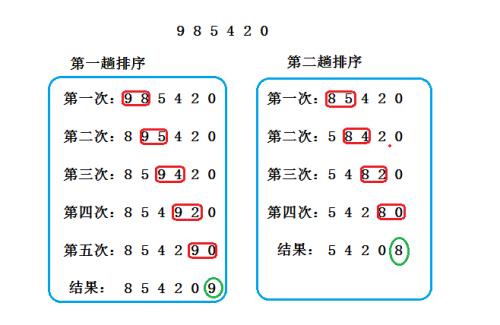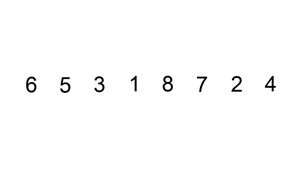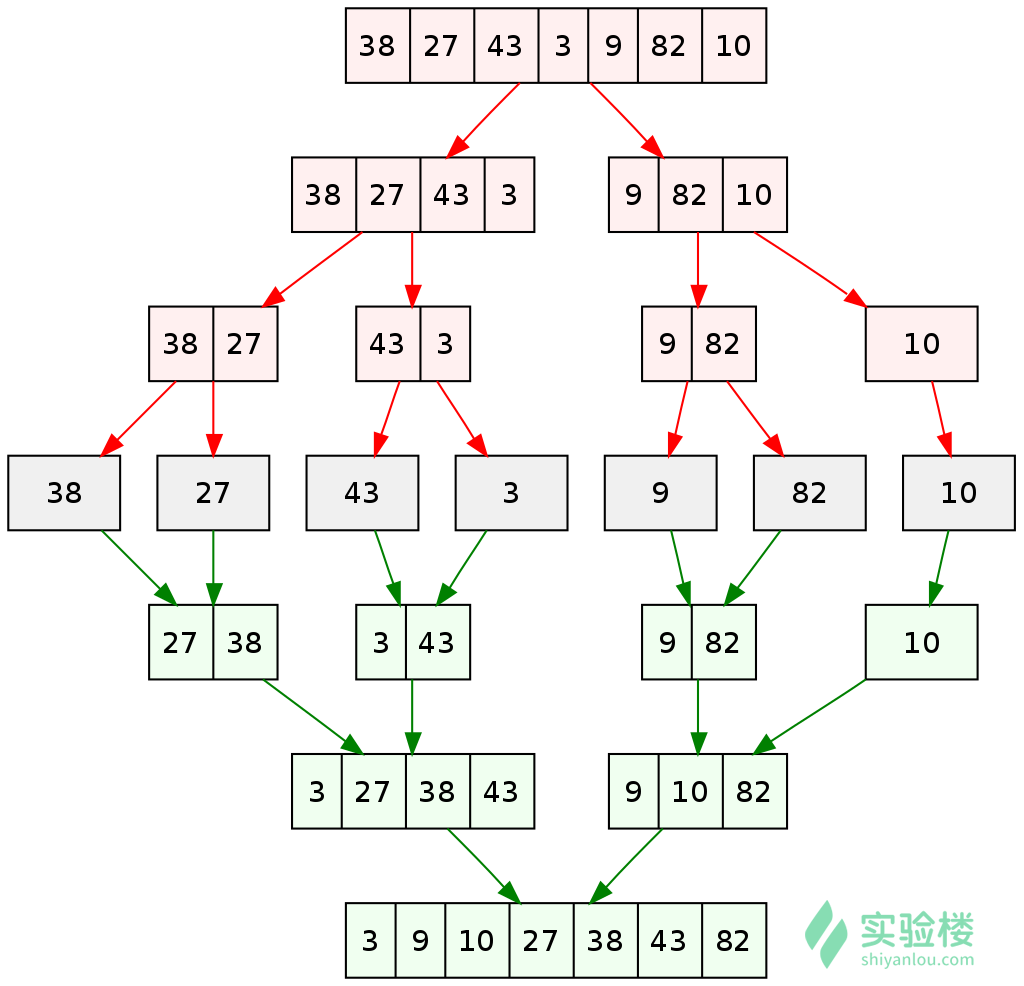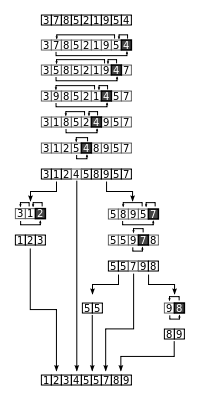The algorithm learning of sort which include Bubblesort,Insertsort,Quicksort and Mergesort.
Notice : these algorithms achieved by Java.
So,let's going to it.
firstly, what is Bubblesort? why we call it in this name?
emmmm.... Maybe this image will give you a clear understanding.

Bubblesort.jpg
I meet so many descriptions,and they all have a common that is : the key which in sorting will end in it's final position!
Bubblesort is stable
there is code:
import java.util.Arrays;
public class BubbleSort{
public static void sort(int[] arr){
for(int i=0;i<arr.length;i++){
for(int j=0;j<arr.length-i-1;j++){
if(arr[j]>arr[j+1]){
int temp=arr[j+1];
arr[j+1]=arr[j];
arr[j]=temp;
}
}
}
}
public static void main(String [] args){
int[] ints={5,3,4,1,2};
sort(ints);
System.out.println(Arrays.toString(ints));
}
}
Secondly,about Insertsort

This sorting is find the appropriate position. when a key is low in front ,they will exchange.
code:
import java.util.Arrays;
public class InsertSort{
public static void sort(int[] arr){
int temp;
for(int i=0;i<arr.length;i++){
for(int j=0;j<i;j++){
if(arr[i]<arr[j]){ temp=arr[i];
arr[i]=arr[j];
arr[j]=temp;
}
}
}
}
public static void main(String [] args){
int [] ints={5,3,4,1,2};
sort(ints);
System.out.println(Arrays.toString(ints));
}
}
Thirdly,the Mergesort.
1,Request space to be the sum of two sorted sequences, which are used to store merged sequences
2,Set two pointers at the beginning of two sorted sequences
3,Compare the elements pointed by the two pointers, select the relatively small elements and place them in the merge space, and move the pointer to the next location.
4,Repeat step 3 until a pointer reaches the end of the sequence
5,Copy all the remaining elements of another sequence directly to the end of the merged sequence

code:
import java.util.Arrays;
public class MergeSort{
public static void mergeSort(int [] arrays,int left,int right){
//如果数组还可以拆分
if(left<right)
{
//数组的中间位置
int middle=(left+right)/2;
//拆分左边数组
mergeSort(arrays,left,middle);
//拆分右边数组
mergeSort(arrays,middle+1,right);
//合并
merge(arrays,left,middle,right);
}
}
/*
合并数组
*/
public static void merge(int [] arr,int left,int middle,int right){
//申请合并空间 大小为两个已经排序序列之和
int [] temp=new int[right-left+1];
//i和j为两个已经排序号的数组的起始位置
int i=left;
int j=middle+1;
int k=0;
while(i<=middle&&j<=right){
//将比较小的数组放入合并空间
if(arr[i]<arr[j]){
temp[k++]=arr[i++];
}else{
temp[k++]=arr[j++];
}
}
//将左边剩余元素写入合并空间
while(i<=middle){
temp[k++]=arr[i++];
}
//将右边剩余元素写入合并空间
while(j<=right){
temp[k++]=arr[j++];
}
//将排序后的数组协会原来的数组
for(int l=0;l<temp.length;l++){
arr[l+left]=temp[l];
}
}
public static void main(String [] args){
int[] ints={5,3,4,1,2};
mergeSort(ints,0,ints.length-1);
System.out.println(Arrays.toString(ints));
}
}
The most important sorting :Quicksort
Quicksort , also known as partition-exchange sort, is short for Quicksort, a sort algorithm, first proposed by Tony Hall. On average, the order of n items is O (nlogn) times. In the worst case, O (n ^ 2) comparisons are required, but this is not common. In fact, Quick Sorting O (nlogn) is usually significantly faster than other algorithms because its inner loop can be achieved efficiently on most architectures.
step:
Pick out an element from a sequence called pivot.
Rearrange the sequence. All elements smaller than the benchmark are placed in front of the benchmark, and all elements larger than the benchmark are placed behind the benchmark (the same number can go to any side). After this segmentation, the benchmark is in the middle of the sequence. This is called a partition operation.
Recursively, the subordinate sequence of elements smaller than the base value and those larger than the base value is sorted.

code:
import java.util.Arrays;
public class QuickSort{
public static void sort(int[] arr,int head,int tail){
if(head>=tail||arr==null||arr.length<=1){
return;
}
//设置数组的起始位置i 结束位置j 基准pivot为数组的中间
int i=head,j=tail,pivot=arr[(head+tail)/2];
while(i<=j){
//当数组小于基准 循环结束后 相当于i所处的位置的值为大于基准的元素
while(arr[i]<pivot){
++i;
}
//当数组大于基准 循环结束后 相当于j所处的位置的值为小于基准的元素
while(arr[j]>pivot){
--j;
}
//如果i<j 那么将交换i j对应位置的值
if(i<j){
int t=arr[i];
arr[i]=arr[j];
arr[j]=t;
//指针继续移动
++i;
--j;
}else if(i==j){
//如果i=j,那么说明本次排序已经结束,将i++ 如果这里不使用i++ 那么后面的sort(arr,i,tial)将改为sort(arr,i+1,tail)
++i;
}
}
//继续将数组分割
sort(arr,head,j);
sort(arr,i,tail);
}
public static void main(String[] args){
int[] ints={5,3,4,1,2};
sort(ints,0,ints.length-1);
System.out.println(Arrays.toString(ints));
}
}
The algorithm learning of sort which include Bubblesort,Insertsort,Quicksort and Mergesort.的更多相关文章
- C++ algorithm 里的sort函数应用
MSDN中的定义: template<class RanIt> void sort(RanIt first, RanIt last); //--> 1)template< ...
- <algorithm>里的sort函数对结构体排序
题目描述 每天第一个到机房的人要把门打开,最后一个离开的人要把门关好.现有一堆杂乱的机房签到.签离记录,请根据记录找出当天开门和关门的人. 输入描述: 每天的记录在第一行给出记录的条目数M (M &g ...
- STL下<algorithm>下的sort函数
定义: sort函数用于C++中,对给定区间所有元素进行排序,默认为升序,也可进行降序排序.sort函数进行排序的时间复杂度为nlog2n,比冒泡之类的排序算法效率要高,sort函数包含在头文件为#i ...
- HDOJ2037 今年暑假不AC (经典的贪心问题)
Description “今年暑假不AC?” “是的.” “那你干什么呢?” “看世界杯呀,笨蛋!” “@#$%^&*%...” 确实如此,世界杯来了,球迷的节日也来了,估计很多ACMer也会 ...
- super fast sort algorithm in js
super fast sort algorithm in js sort algorithm Promise.race (return the fast one) Async / Await // c ...
- greedy algorithm, insertion sort, quick sort
always makes the choice that seems to be the best at that moment. Example #1: @function: scheduling ...
- 选择排序、快速排序、归并排序、堆排序、快速排序实现及Sort()函数使用
1.问题来源 在刷题是遇到字符串相关问题中使用 strcmp()函数. 在函数比较过程中有使用 排序函数 Sort(beg,end,comp),其中comp这一项理解不是很彻底. #include & ...
- 反向输出及sort排序
建立条件:#include "algorithm"引用这个头文件 1.reverse 的用法,反向排序,由自己输入5个数: 1 2 3 4 5 for (int i = 0; i ...
- qsort函数、sort函数【转】
http://blog.163.com/yuhua_kui/blog/static/9679964420142195442766/ 先说明一下:qsort和sort,只能对连续内存的数据进行排序,像链 ...
随机推荐
- tcp与ip协议的区别
TCP/IP(TransmissionControlProtocol/InternetProtocol的简写,中文译名为传输控制协议/互联网络协议). 简单地说,就是由底层的IP协议和TCP协议组成的 ...
- swoole 版本查看
php --ri swoole php --ri swoole | grep Version 查看swoole版本 php -m | grep swoole 查看swoole拓展是否安装成功(ph ...
- mongodb基本的配置和使用
一.连接配置,使用自动配置方式,在applicaiton.properties中配置连接信息即可 spring.data.mongodb.host=127.0.0.1 //连接地址 spring.da ...
- CSS 屏幕大小自适应
要想实现css屏幕大小自适应,首先得引入 CSS3 @media 媒体查询器: media的使用和规则: ①被链接文档将显示在什么设备上. ②用于为不同的媒介类型规定不同的样式. 语法: @medi ...
- The Quad - Directory Explorer(一款四窗口的文件资源管理器)
官网:http://www.q-dir.com/ 参考这位兄弟的介绍:https://www.cnblogs.com/clso/p/4694486.html 一款四窗口的文件资源管理器.
- webpack分片chunk加载原理
首先,使用create-react-app快速创建一个demo npx create-react-app react-demo # npx命令需要npm5.2+ cd react-demo npm s ...
- James Munkres Topology: Theorem 20.3 and metric equivalence
Proof of Theorem 20.3 Theorem 20.3 The topologies on \(\mathbb{R}^n\) induced by the euclidean metri ...
- 通过创建制定版本react-native项目解决“Unable to resolve module `AccessibilityInfo` ”的问题
react-native init MyApp --version 0.55.4 注:不能将--version简写成-v
- 关于jQuery的append方法不能多次添加同一个DOM元素的解决方法
资料来自:https://segmentfault.com/q/1010000007677851?_ea=1419689 append()方法在jQuery中是使用appendChild()实现的,实 ...
- SpringBoot配置文件
一.配置文件 配置文件应该是无论在哪个框架中都是一个重要角色,而我们最为常用的xxx.xml和xxx.properties,还有springboot推荐使用的xxx.yml. 二.SpringBoot ...
